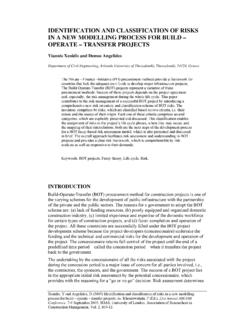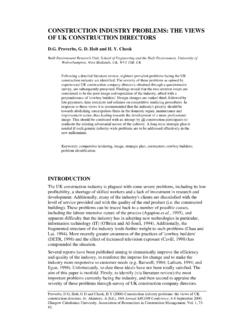Transcription of GUIDE TO PREPARING PAPERS FOR SUBMISSION TO ARCOM …
1 GUIDE TO PREPARING PAPERS FOR SUBMISSION TO. ARCOM CONFERENCES. The writing of PAPERS is only the first step to publishing. Getting a paper included in conference proceedings involves authors in editing and laying out their own PAPERS . Precise specifications for laying out the paper help to reduce the work of the conference organizers in compiling the proceedings. Font sizes, paragraph formats and other details are specified so that proceedings can be presented in a consistent and professional style. This document is formatted according to the guidelines, in order to provide an example for authors. Please refer to this document for assistance when using the ARCOM paper template to write your paper. The ARCOM paper template a Word file containing only the styles needed to prepare your paper is available from Keywords: keywords in lower case and alphabetical sequence separated by commas, finishing with full-stop.
2 INTRODUCTION. Each element of this document is formatted according to particular styles, which are the same as those defined within the ARCOM (Microsoft Word) template. The ARCOM paper template ( ) includes all the styles that you will need, and has been locked in order to limit you to just those styles. For example, if you paste text from another document, the inserted text will automatically be converted to Normal' style; Times New Roman 12, with 6pt spacing after the paragraph. You may then want to apply the styles provided within the template. STRUCTURE OF THE DOCUMENT. The title of the paper should be specific, making clear what the paper is about without demanding that the paper be read in order to ascertain its contents. Although the style (Paper_Title) will force all text to appear as upper case, you should type it in lower case (except for the initial letter and proper nouns) to ensure that the case is correct in the index of the proceedings.
3 The same approach lower case except for the initial letter and proper nouns should also be adopted for all headings in your paper. Main headings will be Section_Heading' style, sub-headings will be Section_Sub-heading' style, and sub- sub-headings will be Minor_Heading' style. If necessary, use bullet points increasing levels of detail below sub-sub-headings. Please note that if you try to apply bold or italics to any text in the ARCOM template, the paragraph will automatically revert to the Normal style. You will then need to re- apply the appropriate Style. Bold and italics can only be used where already included in the styles, within headings and captions. If you do not use the template, we will copy your text into the template on your behalf, perhaps producing a layout and heading structure that you did not intend. AUTHORS. Please do not include author details on the paper to allow for blind review.
4 We will insert the author details at the final edit stage and take these details from MyARCOM. Thus, please make sure the system is up to ADDRESSES. Please see comment under AUTHORS. WRITING INFORMATIVE ABSTRACTS. Abstracts are often the least considered but most important part of any paper. Most readers of a journal or conference proceedings will read most of the abstracts, but very few will read the full PAPERS . Perhaps 95% of readers will read only the abstract. The need for abstracts to be terse often causes difficulty and can taint what is otherwise a perfectly acceptable style of writing. Certain problems are common. Some of the recommendations here are based upon accepted good practice in abstract writing;. others are simply a question of style or consistency. The following suggestions should help to reduce the need for authors to re-write their abstracts. The abstract should not be a table of contents in prose, neither should it be an introduction.
5 It should be informative. Tell the reader what the research was about, how it was undertaken and what was discovered, but not how the paper is organized. The main findings must be summarized. If there are too many of them, then just exemplify them in the abstract. The essential elements of the abstract are: Background: A simple opening sentence or two placing the work in context. Aims: One or two sentences giving the purpose of the work. Method(s): One or two sentences explaining what was done. Results: One or two sentences indicating the main findings. Conclusions: One sentence giving the most important consequence of the work. The following guidelines have been extracted from recent criticisms of real abstracts. This may help to overcome some of the most frequent problems: Please leave the footers empty Do not commence with "this paper ", "this report " or similar. It is better to write about the research than about the paper.
6 Similarly, do not explain the sections or parts of the paper. Avoid sentences that end in " is described", " is reported", " is analysed". or similar. These are simply too vague to be informative. Do not begin sentences with "it is suggested that ", "it is believed that ", "it is felt that " or similar. In every case, the four words can be omitted without damaging the essential message. Do not write in the first person in any form. Thus, not only should you avoid "I", but also "we", "the author", "the writer" and so on. Again, this is because the abstract should be about the research, not about the act of writing. Finally, here is a spoof abstract which contains some of the worst practices in abstract writing: This paper discusses research that was undertaken in the author's country. A. theoretical framework is developed from a literature search and this is used by the authors as the basis of an analytical model.
7 The researchers collected data within this framework and analysed it according to the precepts laid down by earlier researchers in the field. The data is used to demonstrate that our understanding can be significantly increased and this is discussed in the light of previous work. Conclusions are drawn and it is shown that these may be useful for practitioners. KEYWORDS. The keywords should help with indexing, so that other researchers might discover your paper by consulting an index of keywords. In a conference on construction management, it would seem somewhat pointless to include construction management as a keyword. Similarly, there is not much point in using building industry as a keyword. Therefore, avoid keywords that are so vague that they would suit every paper in the conference. On the other hand, some keywords are too specific and only one paper (yours) would appear next to an entry for such a keyword.
8 We need to strike a balance. Keywords should generally be words, not phrases. It may be helpful to choose from a list of recommended keywords for this topic. Although this is not mandatory, Table 1 provides a list of suggested keywords that have been found to be useful and pitched at the right level between vague and unique. The list of keywords should be preceded by the Keywords: and then listed alphabetically, separated by commas, with a full-stop at the end. Please do not select more than five keywords. INTRODUCTION OF THE PAPER. Begin the paper with statements introducing the general area and the reason that this work is important. Explain what was important about the particular approach and how this work relates to previous work in the field. Please leave footer empty Sub-heading It is helpful to break the argument into steps by the use of sub-headings. In a paper of this length, there is little to be gained from going to further levels of sub-sub-heading.
9 With only two levels, heading numbering is not needed. Table 1: Suggested short -list of keywords in construction management research Arbitration Ethics Organization Architecture Expert systems Organizational analysis Artificial intelligence Facilities management Organizational culture Asset management Financial accounting Org'al psychology Automation Fire Partnering Benchmarking Forecasting Personnel Bidding Future studies Pollution Briefing Fuzzy logic Post-occ. evaluation Buildability Geographic info. systems Practice management Building defects Globalization Prefabrication Building performance Government Price Building regulation Green buildings Procurement Building surveying Health and safety Productivity Business strategy Highways Professionalism Cash-flow forecasting Housing Project management Civil engineering Human resource mgnt Property development Claims Industrialization Quality Client Information management Quantity surveying Communication Information technology Rationality Competitiveness Innovation Recruitment Conflict Insolvency Recycling Construction planning Intermediate technology Refurbishment Contract law International comparison Research methods Contracting Knowledge-based syst.
10 Risk Contractor selection Labour Robotics Corporate planning Leadership Sick building syndrome Corporate strategy Liability Simulation Cost Life cycle Sociology Craft Litigation Standardization Decision analysis Maintenance mgmt Statistical analysis Decision theory Management accounting Stress Design Management info. Systems Sub-contracting Design and build Management of the firm Sustainability Design management Marketing Technology transfer Developing countries Material management Tendering Dispute resolution Measurement Time Documentation Modelling Total quality management Econometrics Motivation Training Economic development Negligence Transaction cost econs. Education Negotiation Value management Energy Network analysis Environmental impact Office design Estimating Operational research TABLES. Tables should be kept as simple as possible. Make sure that they are referred to from the text (see Table 2).









